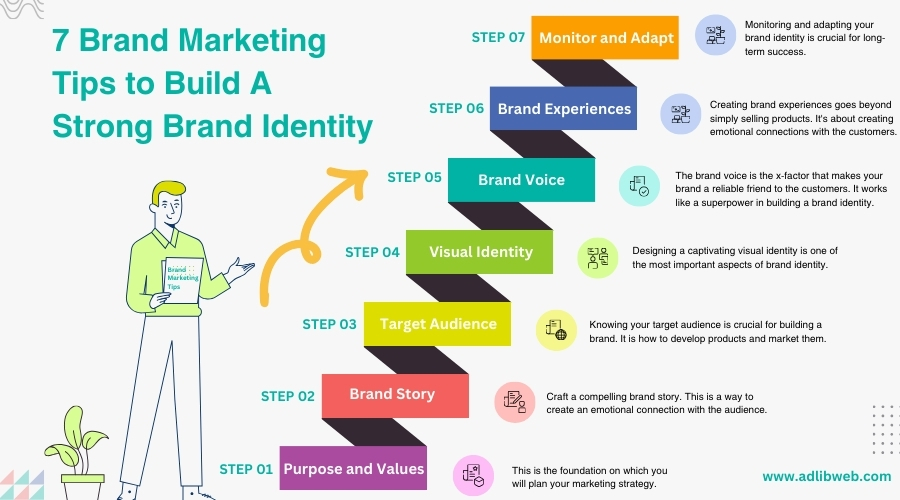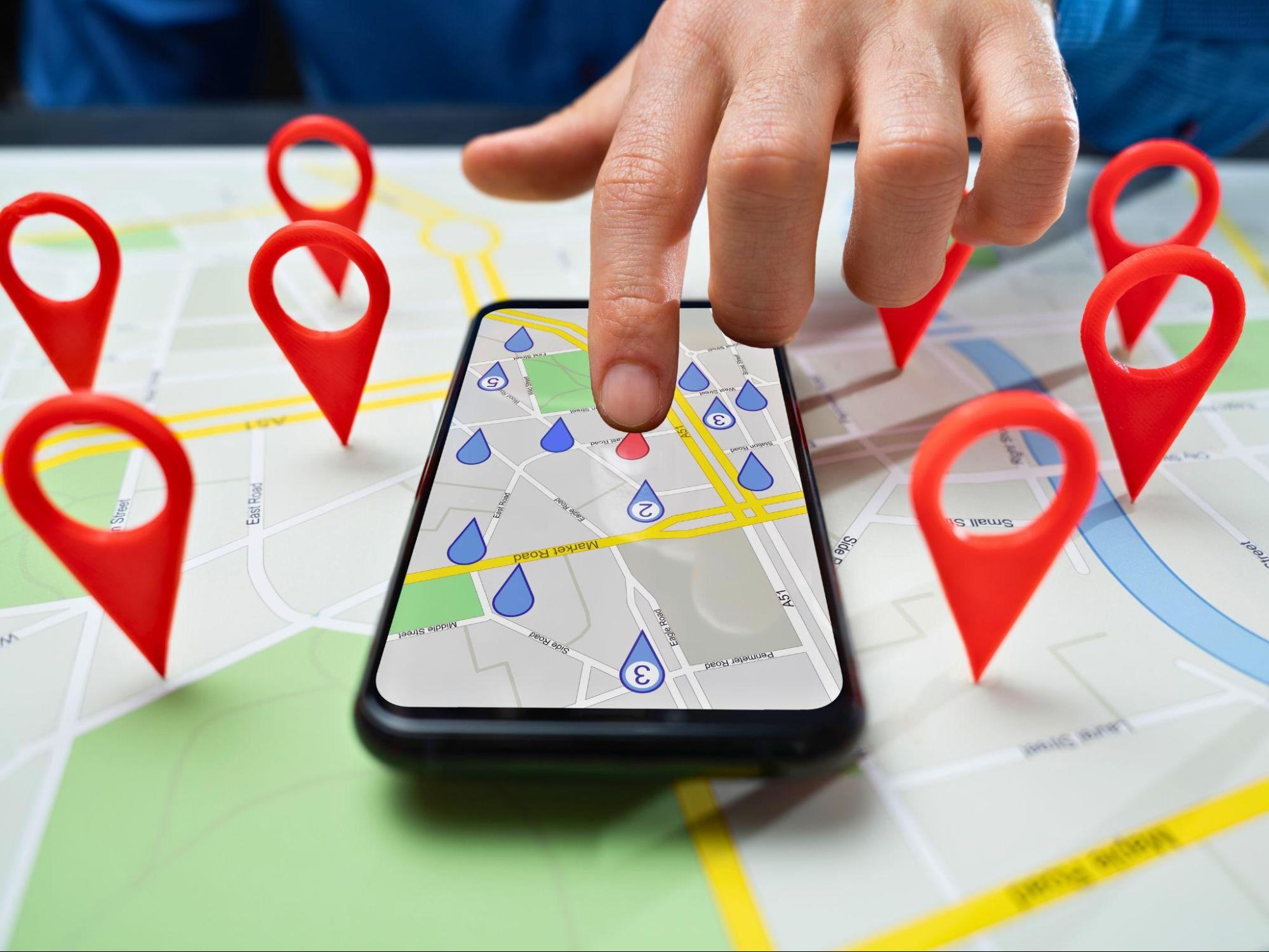Best 7 Brand Marketing Tips to Build A Strong Brand Identity
You must have a clear brand goal that defines the brand’s value. Then you must have an impressive brand story targeting your audience.
Quick Links
Then you have to develop a strong brand voice with an eye-catching visual identity. It is not about the product or service. It is the positive experience that makes your brand flourish.
This is how a brand identity develops. Here will discuss these steps in detail so you can also make your brand stand out.
What Does the Brand Identity Mean?
Brand identity is not just the logo or a fancy tagline. A brand identity is the soul of a brand. It reflects what people think about the brand and what it stands for.
Also, the brand identity is the measure of what anyone cares about the brand. It is the promise that you made to your customer and that brings you revenue. So, brand identity is the overall atmosphere, and service experience that draw customers back for more.
Brand Identity is not only making bundles of revenue for your business. Standing a brand consists of many aspects. You should keep the promises that you will make to your customers. Making a place on the market is tough, you need to catch the eyes of your competitors. You can read other brands’ reviews which are available all over the internet, and websites like ‘yelp’, ’ Wikilearns’, or ‘Yellow Pages’. And make a good strategy to achieve your goals in the future.
However, building a brand identity is not so easy. The company you have created needs to create an emotional connection with the customers. You have to gain the trust of the customers with high-quality services and a smooth experience. That’s why, brand identity is a must to sustain in this competitive marketplace. It’s the knight in shining armor that slays the dragon of low recognition.
Why Do Businesses Need Brand Identity?
Customers are the controllers. And they get plenty of options in the same niche. If you can’t build a unique identity, your competitors will take the position.
So, whatever the size of your business is, you have to build the brand Identity. It will make your brand recognized by the customers. Moreover, it is the magic that transforms a mere product into an experience.
Still confused about the necessity of brand identity? Let’s discuss more specific benefits of a strong brand identity:
Recognition and Differentiation
Imagine walking into a supermarket with hundreds of indistinguishable cereal boxes.
Which one would you grab?
Probably the one with a familiar mascot that goes with your necessities. This is how a strong brand identity influences the purchasing decision.
A strong brand identity works in that way. It creates a lasting impression that influences purchasing decisions.
Trust and Credibility
A strong brand identity reflects professionalism. The high-quality marketing materials show your customers that you’re not just a fly-by-night operation.
Your brand identity makes you reliable to your potential customers. As a result, it brings conversation.
Customer Loyalty and Advocacy
A strong brand identity creates an emotional connection with the buyers. And when customers get emotionally connected with a brand, they become advocates of it.
Thus, it creates customer loyalty. It encourages customers to recommend your products to their families and friends.
Employee Engagement and Motivation
A strong brand identity isn’t just for external audiences. A brand identity works as the most vital for internal morale.
Employees become more engaged with the brand’s value and mission. They feel proud to be a part of your team.
Thus the internal atmosphere of the company becomes more positive. As a result, it boosts the conversation.
Competitive Advantage
Your brand identity is the best weapon to stand out in this competitive marketplace.
Moreover, it allows you to command premium pricing. You can take examples from the top brands in the world. The product pricing of brands like Nike, Adidas, Gucci, and Prada looks higher than the same products of lower-ranked brands.
It is the brand identity that has brought this company a competitive advantage.

7 Brand Marketing Tips to Build A Strong Brand Identity
In this fast-paced world, creating a brand identity is a must for every business. However, getting the desired result is a challenging task.
You have to follow a systematic process to create a strong brand presence. Here are 7 brand marketing tips that you should follow to build your brand identity.
01. Define the Brand’s Purpose and Values
The first step in building a brand identity is defining the brand’s purpose and values. This is the foundation on which you will plan your marketing strategy. By defining the purpose and value, you let people know what they will get from your brand.
Brand Purpose
You can define brand purpose by asking the following questions;
- Why does your brand exist beyond simply making money?
- What positive impact do you want to have on the world?
- What problem are you trying to solve for your customers?
We can give you the example of Patagonia. Their purpose is “to build the best product, cause no unnecessary harm, use business to inspire and implement solutions to the environmental crisis.”
Moreover, Tesla’s purpose is “to accelerate the world’s transition to sustainable energy.”
Brand Values
To define brand value, you should ask the following question:
- What core principles guide your actions and decisions?
- What is your company culture that resonates with your target audience?
Google’s core values include a focus on the user, innovation, and a democratic approach to information. Nike’s values include passion, innovation, and human potential.
Here are some quick brand marketing tips for defining your brand’s purpose and values:
- Ask yourself and your team why your brand matters.
- Understand your target audience’s needs.
- Analyze successful brands
- Avoid jargon and focus on core principles.
- Integrate them into your company culture.
02. Craft Brand Story
Craft a compelling brand story. This is a way to create an emotional connection with the audience. So, you have put your heart into creating a story that reflects your purpose. To create your brand story these are questions you have to ask yourself:
- What does your brand do?
- What makes you unique?
- Who is your target audience?
- What are your brand values?
- What kind of emotion do you want to evoke?
Suppose, you are a bakery that uses locally sourced ingredients to create delicious and healthy breads. You could craft a story about a family of bakers who have been nourishing their community for generations. You can tell about the use of time-honored recipes and fresh, natural ingredients.
Tips for Creating A Winning Brand Story
Crafting a compelling Brand Story is all about understanding the passion and qualities of your business.
Here are some tips to get you started:
- Craft content understanding your brand philosophy.
- Prioritize sustainability, innovation, and community engagement.
- Frame your story as a quest for the perfect brew.
- Heroic journeys inspire people the most. So, highlight the challenges you overcame, triumphs achieved, and lessons learned.
- Share the personal journey of your founders and their passion for crafting exceptional beer.
- Emphasize connecting with the local community. You can make partnerships with farms or other businesses.
- Use evocative imagery of your product and service.
- Humor and personality can go a long way! Find the voice that reflects your brand and target audience.
03. Know Your Target Audience
Knowing your target audience is crucial for building a brand. It is how to develop products and market them.
So, Create a detailed profile of your ideal customer. This includes demographics like age, gender, income, location, and interests.
Now go deeper to understand the motivations of your customers that will make them buy your products. pain points, and values. So, you have to conduct deep marketing research. Surveys, interviews, and social media listening can help you to get insights from potential customers.
You can also get customer demographics from your website data and social media handles. Do some competitor analysis to understand their online behavior. It will help you to create strategies to attract customers to your brand.
Moreover, you have to be up-to-date with the trends. Customers are attracted to the materials that go with the trend. Also, this is the main digital marketing strategy followed by the top marketers.
Here are some quick tips for knowing your target audience:
- Consider the age range of the targeted audiences.
- Where do they live? Do they live in urban, suburban, or rural areas?
- Create gender-specific marketing plan
- What is their average income level?
- Consider their educational background and level of understanding.
- What are their hobbies and passions?
- Are your audiences busy professionals, young families, or active retirees?
- What platforms do they use? What kind of content do they engage with?
- Learn about their online shopping habits.
04. Design Your Visual Identity
Designing a captivating visual identity is one of the most important aspects of brand identity. A brand’s visual identity is the digital recognition of it. You have to build an identity so that people see a video or photo of yourself and immediately recognize it.
Here is how to design a brand’s visual identity:
- Your brand’s visual identity should also describe the objectives of your brand. Then try to maintain consistency.
- Try to portray the philosophy of the brand. Then choose the color palettes, typography, and imagery that represent your thoughts attractively.
- Also, understand the audience’s visual preferences in designing graphics. Conduct deep market research to understand what aesthetics your customers respond to. If they are drawn to minimalism, create designs to meet their preferences.
- If we talk about the logo, it is the brand’s anchor. It has to be simplified and precise. Thus customers will easily get connected to it.
- Ensure consistent application of your visual guidelines. This builds brand recognition and strengthens your brand identity in your audience’s minds.
05. Find Your Brand Voice
The brand voice is the x-factor that makes your brand a reliable friend to the customers. It works like a superpower in building a brand identity. Using a brand voice, you can directly interact with your potential customers.
Thus, it will make your audience more interactive. You will become more trustworthy to your audiences. As a result, you will generate sales from the business.
Here’s how to find your unique brand voice and make it sing:
- Imagine your ideal customer sitting across from you. What tone would you use? Understanding their preferences is key to crafting a voice that resonates.
- Is your brand bold and adventurous? Your voice should embody your brand’s core values. Try to create a consistent and recognizable experience.
- Think of words that describe your brand’s essence. Words like “authentic,” “innovative,” or “empowering.” These keywords will guide your voice.
06. Create Brand Experiences
Creating brand experiences goes beyond simply selling products. It’s about creating emotional connections with the customers.
Here’s how to ignite brand experiences that spark loyalty and fire up your customer base:
- Map out every interaction point your audience has with your brand. Every touchpoint is an opportunity to weave your brand story and values into the experience.
- Go beyond functionality and tap into emotions. Create experiences that evoke joy, surprise, or a sense of belonging.
- Weave narratives into your experiences. Use visual storytelling, interactive elements, or even customer testimonials.
- Tailor your experiences to individual preferences and needs. Offer personalized recommendations and interactive elements.
07. Monitor and Adapt
Monitoring and adapting your brand identity is crucial for long-term success. It’s like holding a compass in uncharted territory. It ensures your brand stays relevant and up to date.
Here’s how to master the art of monitoring and adapting:
- Track how easily people recognize your brand through surveys, social media mentions, and website traffic.
- Gauge customer sentiment through feedback surveys, reviews, and customer service interactions.
- Analyze metrics like sales figures, market share, and engagement to measure the effectiveness of your brand strategy.
- Track brand mentions and sentiment across social media to understand your audience’s perception.
Final Thoughts
Here I have tried to provide the top 7 brand marketing tips in detail. Following these tips you can create a winning marketing strategy. Thus you will develop a brand identity that will bring success for the business.
However it is an options process, so go one step ahead every day. And adapt your strategy to the market demand to get the desired output.
Top 10 Magento 2 SEO Extensions to Boost Your Store’s Visibility
SEO is the key to a successful store! Have you ever given thought, if your store is simply…
0 Comments12 Minutes
How to Optimise Your PPC Campaigns with AI
As the methods of Internet marketing evolve, Pay-Per-Click (PPC) advertising remains one of the…
0 Comments10 Minutes
Putting Cybersecurity Under the Spotlight: How Security Audits Strengthen Your Defenses
While organizations understand the importance of cybersecurity, there is an opportunity for many…
0 Comments12 Minutes
How Marketing Agencies Can Choose the Best High-Performance SEO Tools
High-performance SEO tools combine comprehensive features, durability, speed, and accuracy. They…
0 Comments9 Minutes
Simplify the Running of Your Business With These Tips
Finding enough hours in the day to tackle all the jobs on your to-do list can be a major issue…
0 Comments4 Minutes
Best SEO Practices for Multi-Location Businesses
Businesses operating across multiple locations benefit from unique opportunities but also face…
0 Comments7 Minutes
Unveiling the 7 Essential Components for an Exceptional Website
Even a beginner can identify what makes a good website, but when it comes to building one, things…
0 Comments8 Minutes
Top Blockchain Trends to Watch in 2024
Blockchain has time and again proved its capacity to redefine many sectors and this prediction of…
0 Comments6 Minutes








